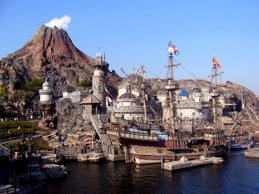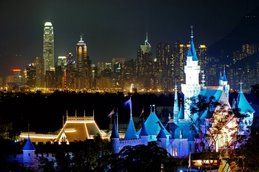The report of the think tank The Shift Project is about a time bomb that nobody have heard about yet but which will explode in years to come at the face of all major companies which invest in streaming like Netflix, Amazon, Apple, Warner, and of course Disney+. And this report couldn't happen at a worst time, two months before Disney launch its streaming service.
What is all this about? Well, you all surely have heard about gobal warming and what is responsible for it, starting by the CO2 emission from cars or planes. Pollution from men doesn't stop there of course and the big thing to fight right now is plastic, something that big companies, starting by Disney, take very seriously, thanks God.
But there is something else that we didn't think or even heard about until now which is about to pollute and warm up the planet anytime soon as much as cars emissions, and it's streaming videos. Believe it or not but in 2018, online video accounted for 60% of Internet data traffic. And it has generated more than 300 million tonnes of CO².
How is this possible? Because the movie you watch on your computer or mobile device, or TVs ,are stored in data centers, then are routed to our terminals (computers, smartphones, connected TVs) by networks (cables, fiber optics, modems, antennas of mobile networks) and all these processes require electricity, of which production consumes resources, and emits CO2! And it's not about to diminish anytime soon. Here is a translation of excerpts from an article of French Liberation newspaper -
you can read it in French HERE.
"Too many people still think that digital is a virtual world and, as such, the pollution it generates is just as virtual. However, this is far to be the case and the report of the think tank The Shift Project published in July 2019, "The unsustainable use of online video," confirms. "We are facing a mythological construction of the digital. The digital is immaterial, we do not see it, it floats around us, "says Maxime Efoui-Hess, project leader within this think tank.
The study starts from this observation: "The digital world today emits 4% of the greenhouse gases of the world, more than civil air transport. This share could double by 2025 to 8% of the total, the current share of car emissions. "
According to a study by Cisco, a company specializing in network hardware, 80% of the data streams are video in 2018. The remaining 20% is traffic generated by websites, e-mails, instant messengers, storage of photos and other data. Among these 80%, the organization excludes TV streaming and live video like Skype for example. Online video accounts for 60% of traffic, or 1.05 trillion billion bytes.
The Shift Project made the accounts and observes that in 2018, viewing videos online generated 306 million tonnes of CO2, or "1% of global greenhouse gas emissions" or the equivalent of "Greenhouse gas emissions of Spain in 2010" [about 311 million tonnes of CO2, ed].
The report divides these online video streams into four usage categories: VOD - that is, videos hosted on streaming platforms like Netflix or Amazon Prime - (34%), pornographic content (27%), content "Tubes" (21%) on YouTube or Dailymotion for example and the rest, that is to say the videos that can be found on social networks including (21%). Including between 20 and 30% of global online video streams, each of these categories therefore has a significant share in the calculation of greenhouse gas emissions.
The report of The Shift Project, which advocates for digital sobriety, namely "prioritizing the allocation of resources according to usage" to "comply with planetary boundaries, while preserving the societal contributions of digital technologies", takes the measure of data traffic generated by the video. Indeed, ten hours of high-definition film correspond to "a larger volume of data than that necessary to contain all the articles in English of the Wikipedia online encyclopedia".
With the growth in the number of Internet users and the increase in the number of connected devices per person, data traffic will grow. A projection from Cisco estimates that it will be around 400 exabytes (memory size unit) per month in 2022 against 150 in 2018. Online video has no problem either. Cisco projects that it will be responsible for 82% of global data traffic worldwide in 2022."
Now, you're going to tell me "wait a minute, so i can't have a car or have to reduce trips by plane, not to mention dozens of other sthings and now i can't watch videos on my computer or mobile device?". Wait, you're not the one directly responsible and watching movies on your TV or computer is not something new. What IS new is that the movies definition are higher than ever, thanks to 4K or Full HD, meaning more datas, etc... and as streaming videos won't stop anytime soon thanks to all the different streaming services then the amount of datas transferred explode, meaning it requires more and more energy, so more C02 emissions, etc...
BUT, the solution must be found first by the companies like Netflix, Amazon, Hulu or soon Disney +, Apple and Warner, and many others. I'm not a specialist in environmental problems so i may be wrong but i think that having the energy needed by the servers provided by solar farms could help to reduce the CO2 emissions. The problem is that i suspect that Disney + , for instance, won't have only one server in the U.S for the whole world but several in different continents. Meaning they'll need to build as many solar farms as they have servers around the world. Good news, Disney knows how to do this as they've created a huge solar farm recently at WDW. Of course it won't reduce YOUR consumption of electricity when you'll watch Disney + at home or on your mobile devices but it should reduce a lot if the energy needed at the start was provided by solar farms.
I strongly suggest to Disney to have a closer look at the problem because for now medias don't talk about this and people are not aware of it, but it won't take long to be on the front pages and, there, Disney will have a BIG problem. I mean, Disney certainly don't want to be accused to be among the companies which is responsible of as much CO2 emissions as all cars around the world, right? If the Mouse don't keep an eye on this and resolve the problem in advance it will happen, and in just a few years. In the meantime, learn more about it with the full report at the links below and remember you've read about it first here on D&M.
The full report from The Shift Project think tank
is available HERE in French and
HERE in English.





































































































